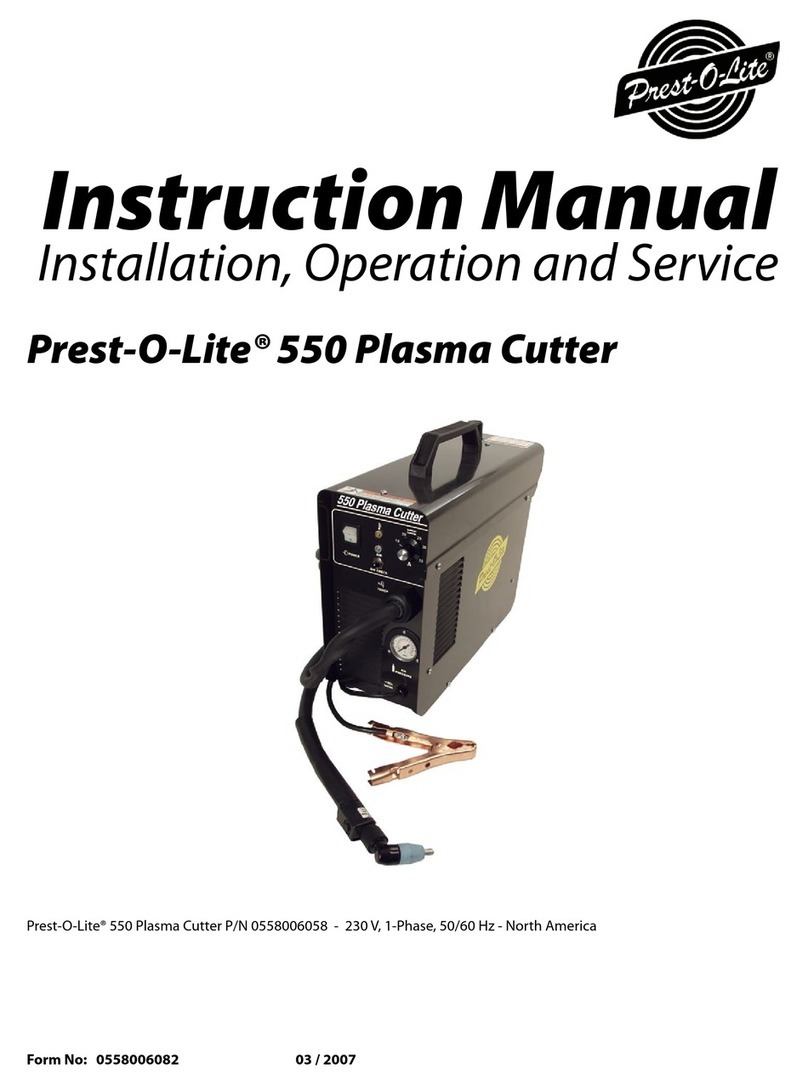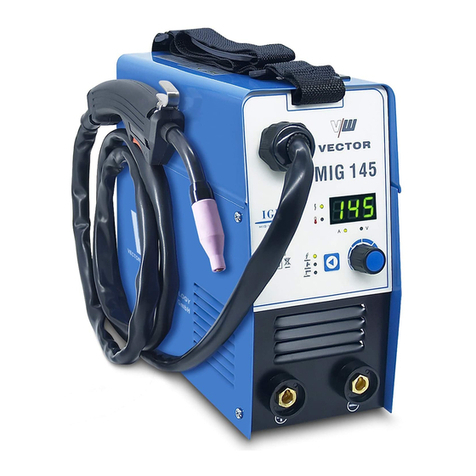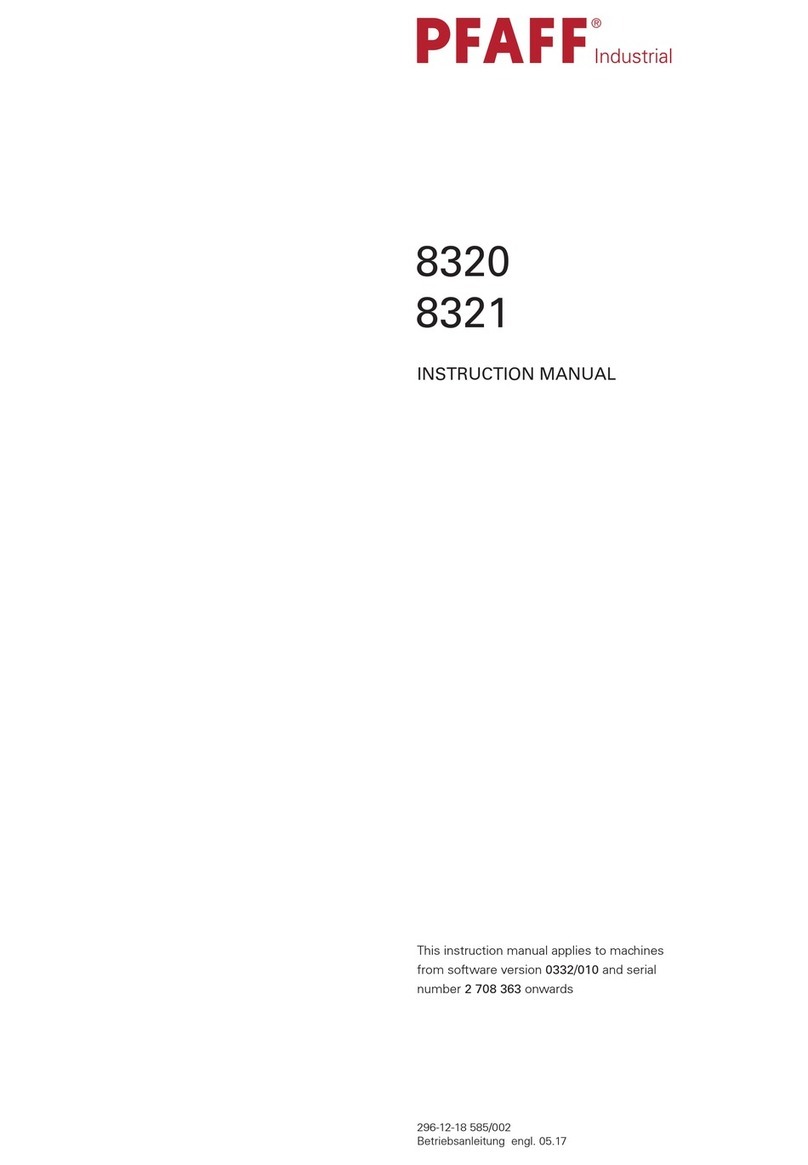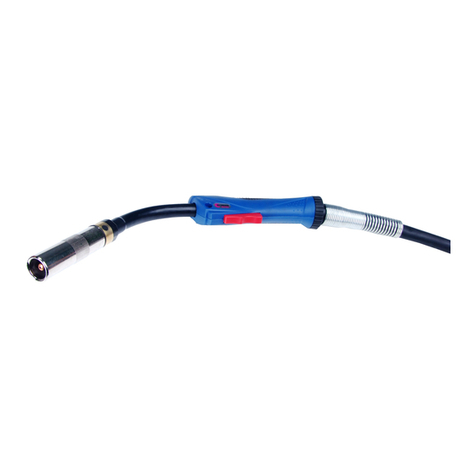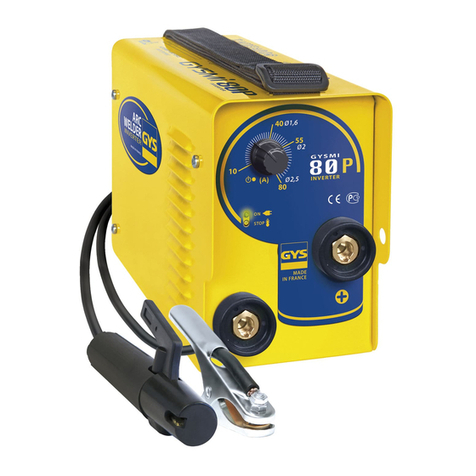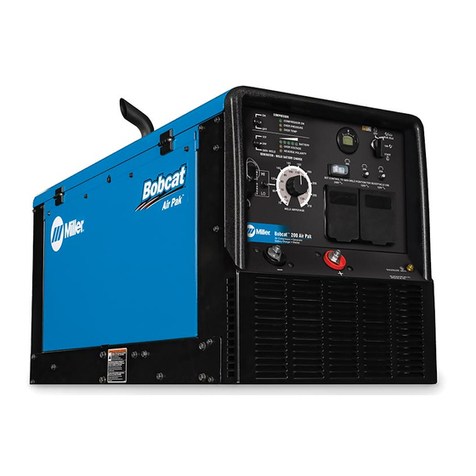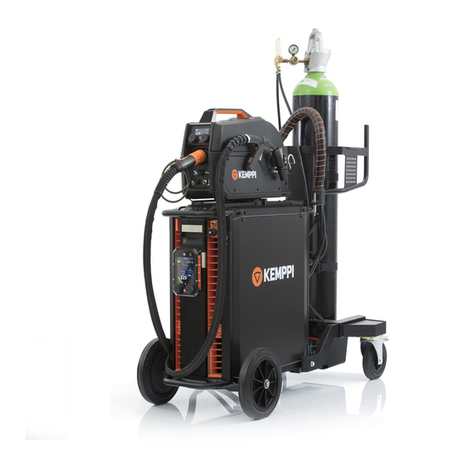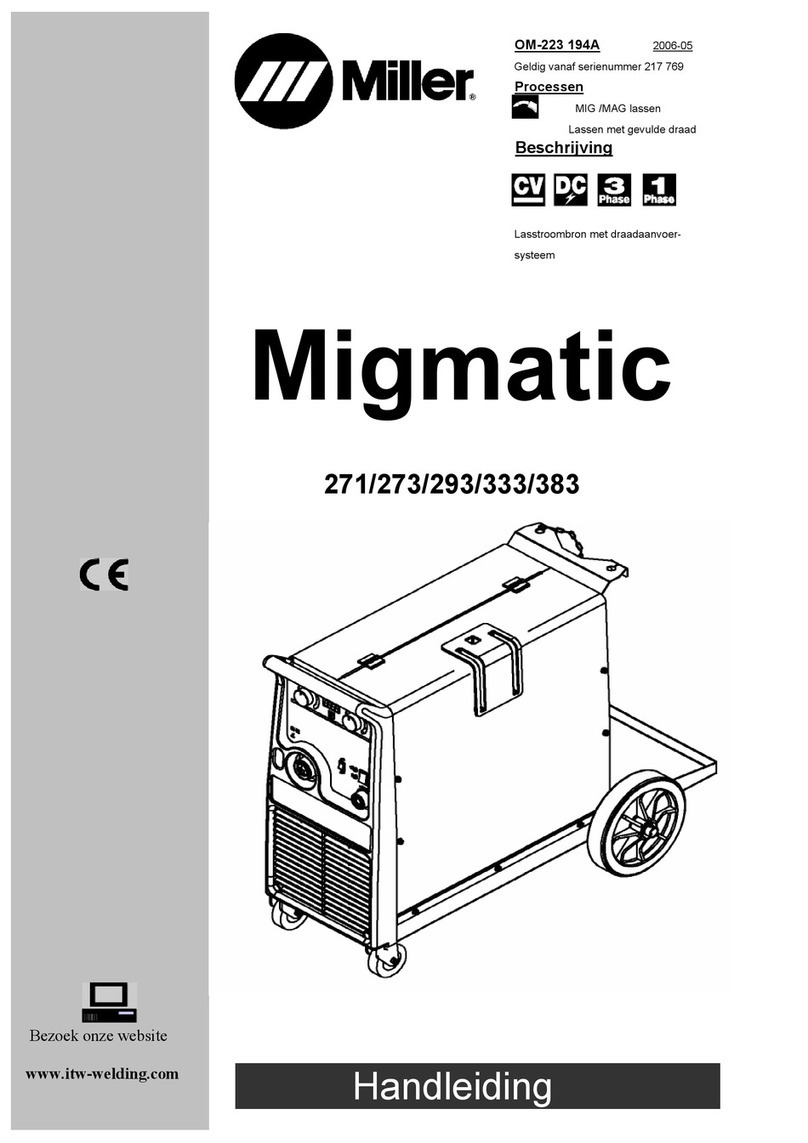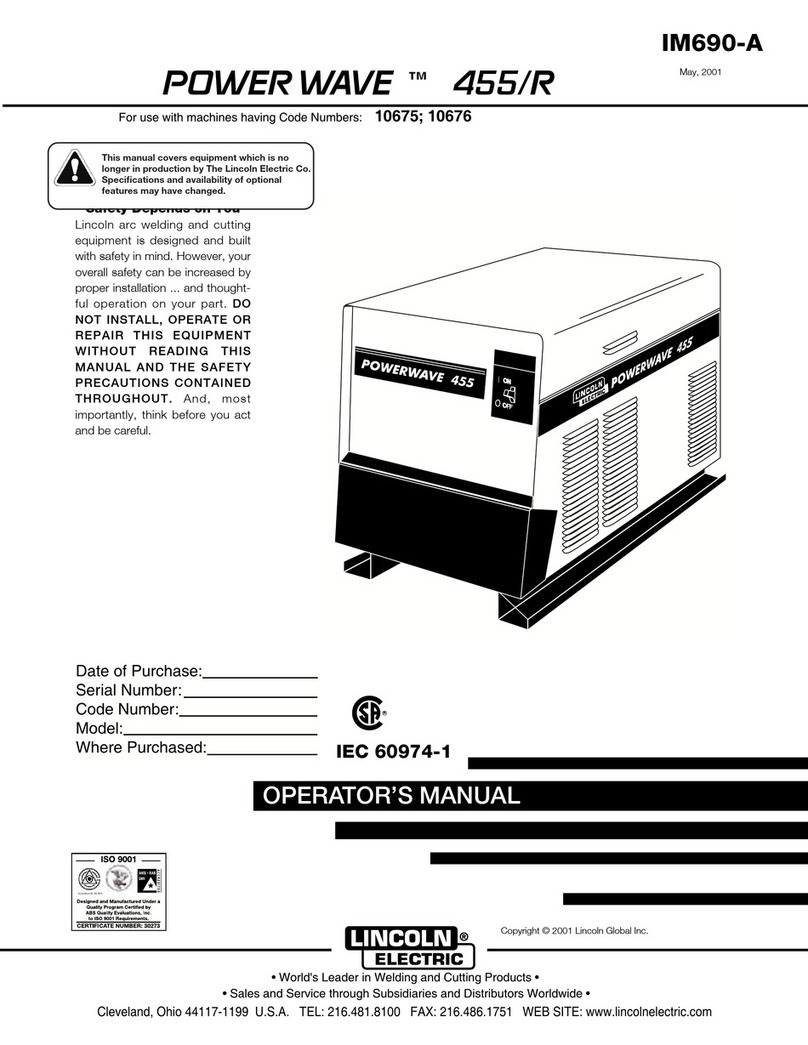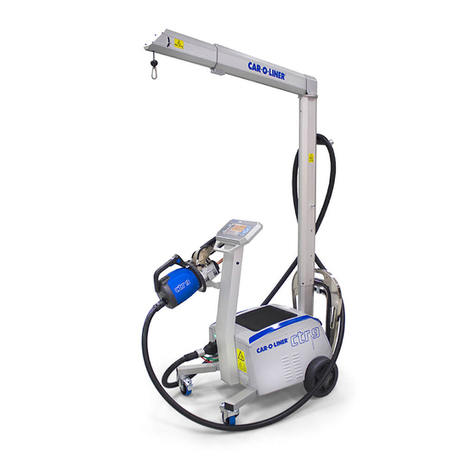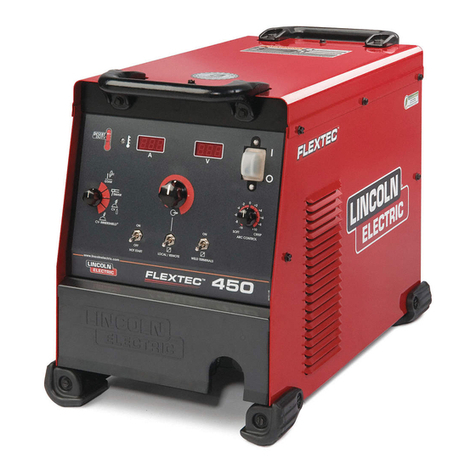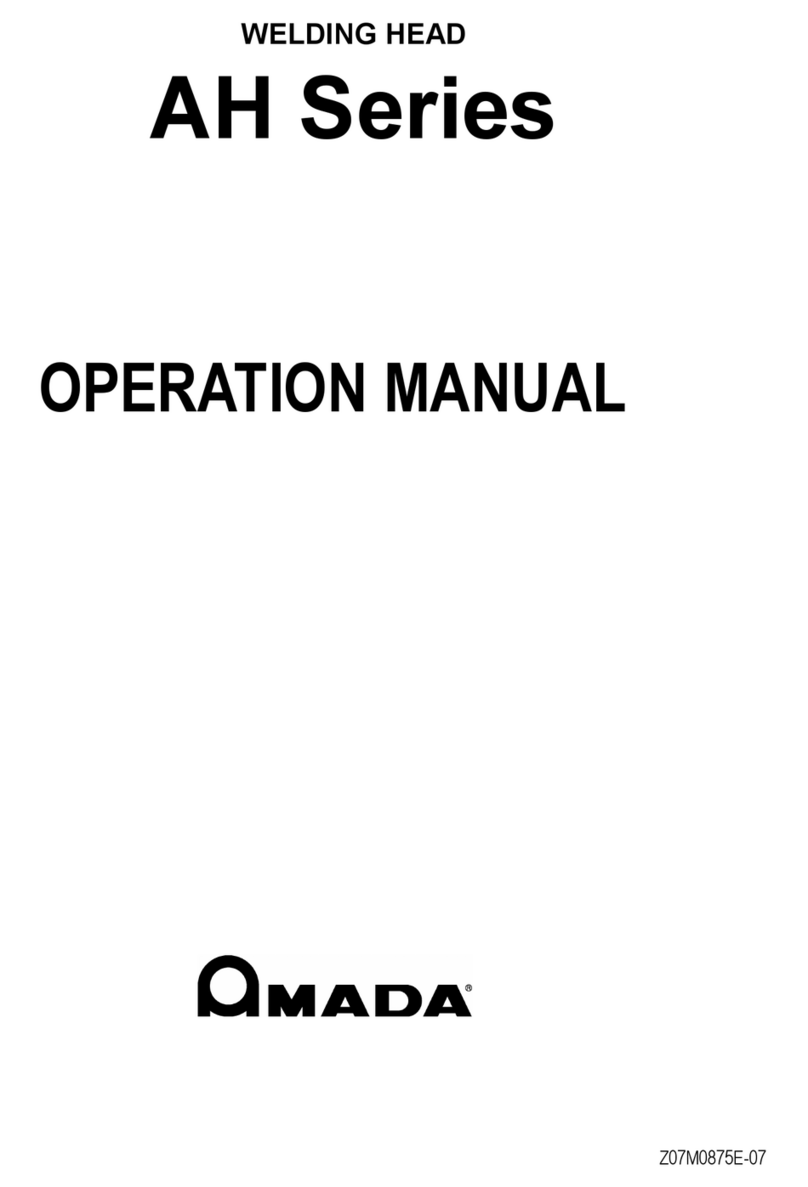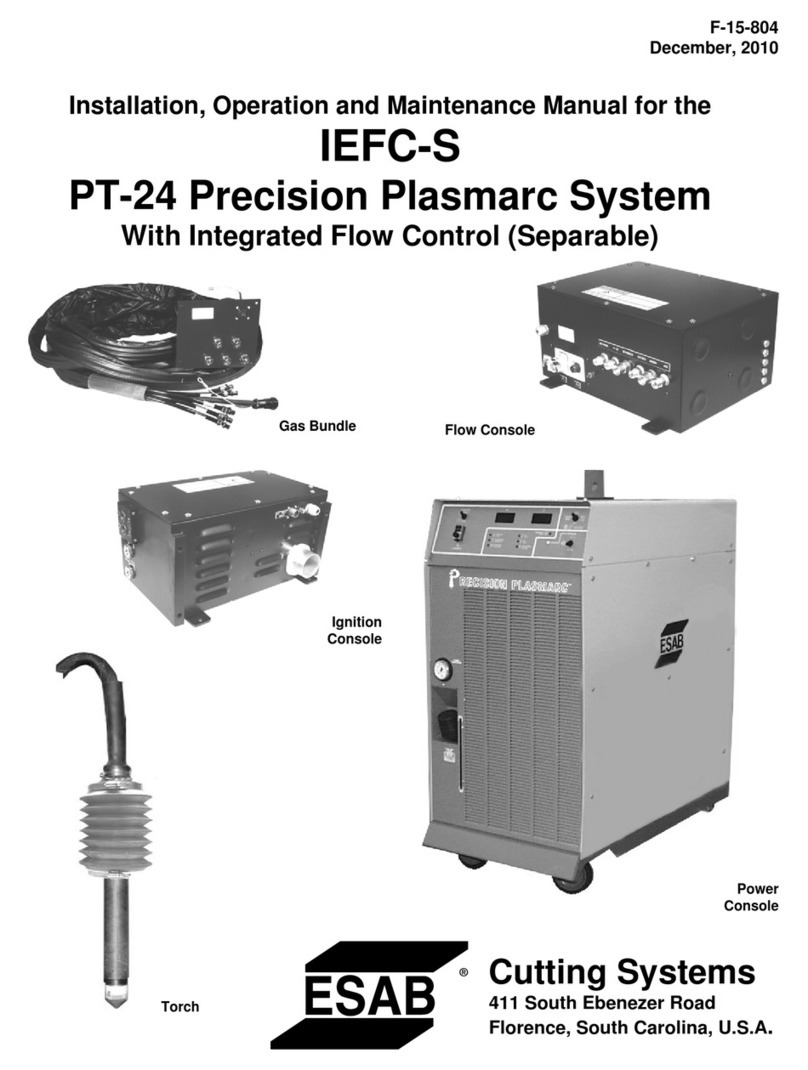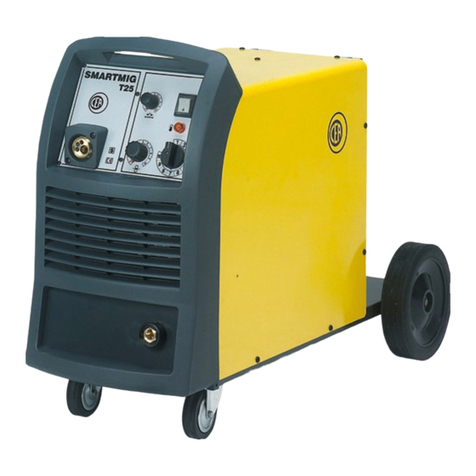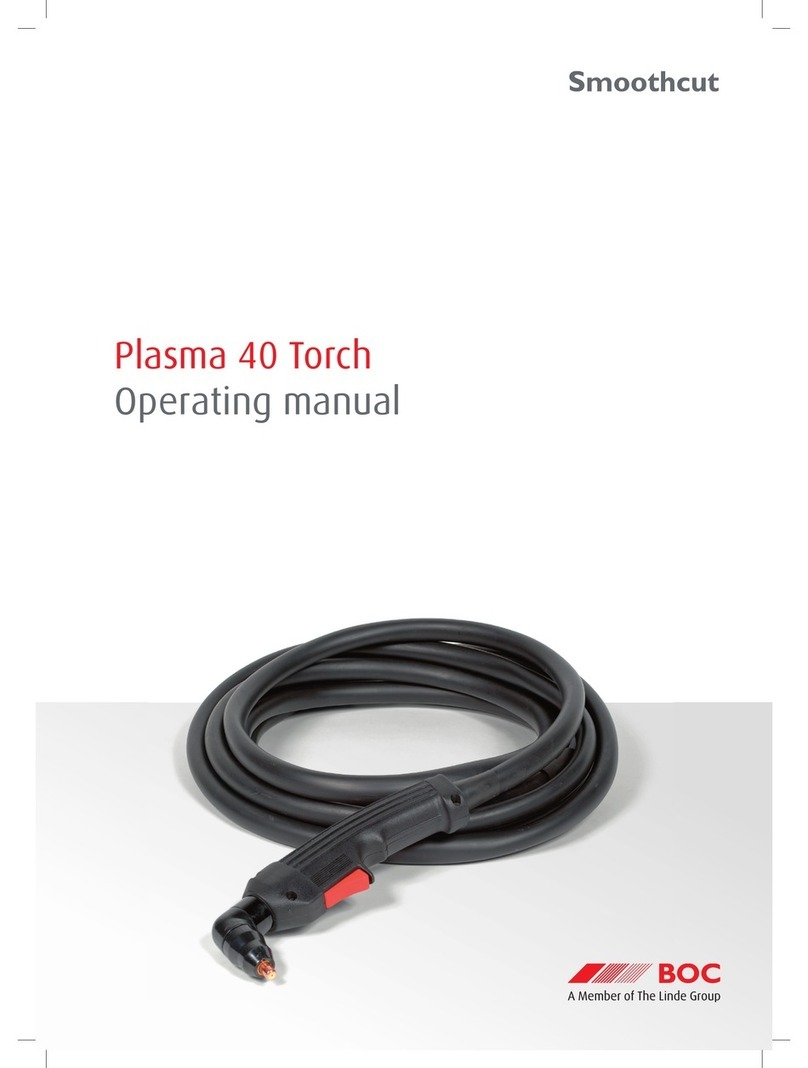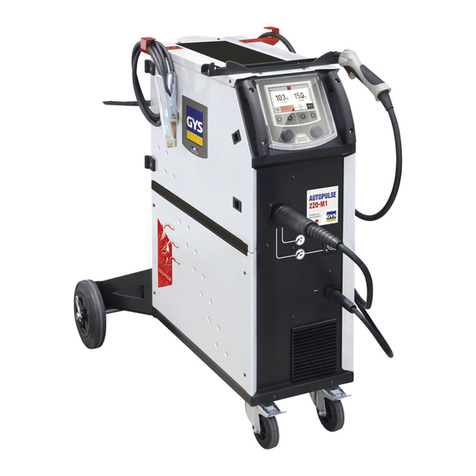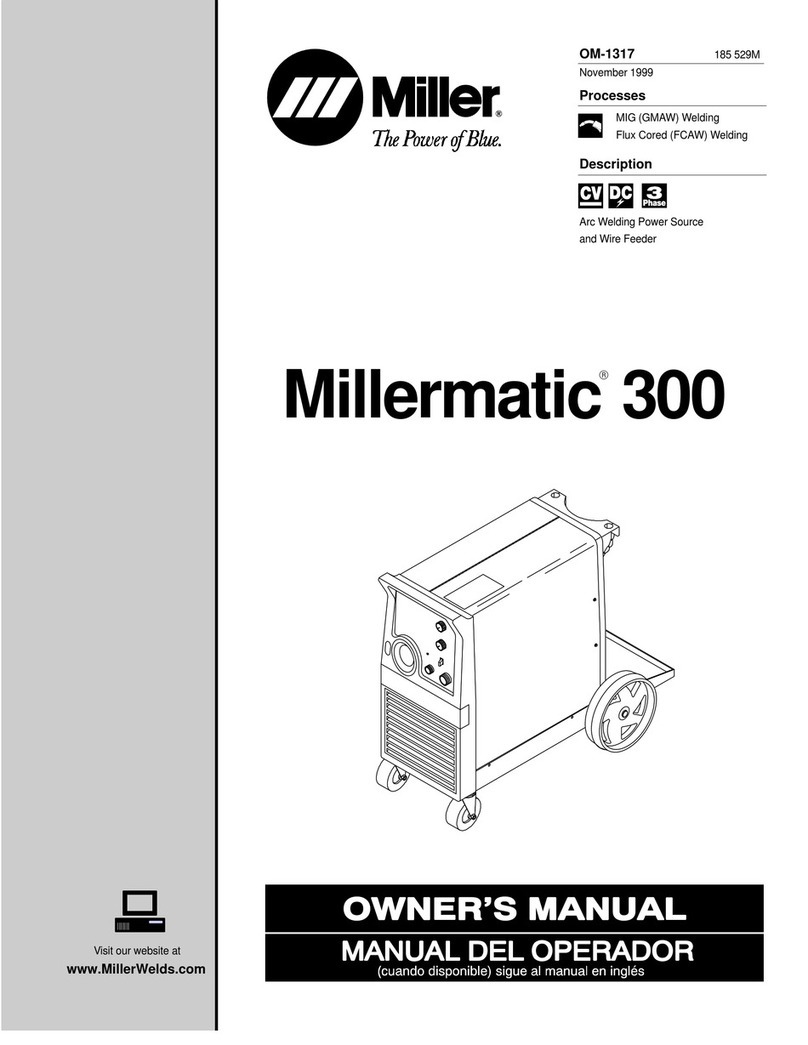Prest-O-Lite 380 User manual

Prest-O-Lite®380 Plasma Cutter P/N 0558006057 - 230 V, 1-Phase, 50/60 Hz
Form No: 0558006081 03 / 2007
Prest-O-Lite®380 Plasma Cutter
Instruction Manual
Installation, Operation and Service

2
These INSTRUCTIONS are for experienced operators. If you are not fully familiar with the principles of opera-
tion and safe practices for arc welding and cutting equipment, we urge you to read our booklet, "Precautions
and Safe Practices for ArcWelding, Cutting, and Gouging," Form 52-529. Do NOT permit untrained persons to
install, operate, or maintain this equipment. Do NOT attempt to install or operate this equipment until you
have read and fully understand these instructions. If you do not fully understand these instructions, contact
your supplier for further information. Be sure to read the Safety Precautions before installing or operating
this equipment.
BE SURETHIS INFORMATION REACHES THE OPERATOR.
YOU CAN GET EXTRA COPIES THROUGH YOUR SUPPLIER.
USER RESPONSIBILITY
This equipment will perform in conformity with the description thereof contained in this manual and
accompanying labels and/or inserts when installed, operated, maintained and repaired in accordance
with the instructions provided. This equipment must be checked periodically. Malfunctioning or
poorly maintained equipment should not be used. Parts that are broken, missing, worn, distorted or
contaminated should be replaced immediately. Should such repair or replacement become necessary,
the manufacturer recommends that a telephone or written request for service advice be made to the
Authorized Distributor from whom it was purchased.
This equipment or any of its parts should not be altered without the prior written approval of the
manufacturer. The user of this equipment shall have the sole responsibility for any malfunction which
results from improper use, faulty maintenance, damage, improper repair or alteration by anyone other
than the manufacturer or a service facility designated by the manufacturer.

3
TABLE OF CONTENTS
SECTION TITLE PAGE
PARAGRAPH
SECTION 1 DESCRIPTION............................................................................................................. 11
1.1 General.......................................................................................................................... 11
1.2 Scope ............................................................................................................................. 11
1.3 System Available........................................................................................................ 11
1.4 Specifications.............................................................................................................. 12
1.5 PT-31XL Torch Technical Data................................................................................ 14
SECTION 2 INSTALLATION........................................................................................................... 15
2.1 General.......................................................................................................................... 15
2.2 Equipment Required................................................................................................ 15
2.3 Location ........................................................................................................................ 15
2.4 Inspection..................................................................................................................... 15
2.5 Primary Electrical Input Connections................................................................. 15
2.6 Secondary (Output) Connections........................................................................ 17
2.6.1 Torch Replacement................................................................................................... 17
2.6.2 Air Connection............................................................................................................ 17
2.6.3 Work Lead Connection............................................................................................ 17
2.7 PT-31XL Torch Consumables Installation.......................................................... 20
SECTION 3 OPERATION ................................................................................................................ 21
3.1 Operation ..................................................................................................................... 22
3.2 Prest-O-Lite®380 Controls....................................................................................... 22
3.3 Assembling PT-31XL Consumable Parts............................................................ 23
3.4 Cutting with the PT-31XL........................................................................................ 23
3.5 Operating Techniques.............................................................................................. 25
3.6 Common Cutting Problems................................................................................... 25
SECTION 4 MAINTENANCE ......................................................................................................... 27
4.1 General.......................................................................................................................... 27
4.2 Inspection and Cleaning......................................................................................... 27
4.3 Flow Switch.................................................................................................................. 27
4.4 PT-31XL Torch Maintenance .................................................................................. 28
4.5 Power Cable And Switch Disassembly Sequence.......................................... 29
SECTION 5 TROUBLESHOOTING .............................................................................................. 31
5.1 Troubleshooting ........................................................................................................ 31
5.2 Troubleshooting Guide ........................................................................................... 31
5.3 Sequence of Operation ........................................................................................... 36
SECTION 6 REPLACEMENT PARTS ........................................................................................... 37
6.1 General.......................................................................................................................... 37
6.2 Ordering........................................................................................................................ 37

4
TABLE OF CONTENTS

5
WARNING: These Safety Precautions are for your
protection. They summarize precautionary infor-
mation from the references listed in Additional
Safety Information section. Before performing any
installation or operating procedures, be sure to read and follow
the safety precautions listed below as well as all other manuals,
material safety data sheets, labels, etc. Failure to observe Safety
Precautions can result in injury or death.
PROTECT YOURSELF AND OTHERS -- Some welding, cutting,
and gouging processes are noisy and re-
quire ear protection.The arc, like the sun,
emits ultraviolet (UV) and other radiation
and can injure skin and eyes. Hot metal
can cause burns. Training in the proper
use of the processes and equipment is essential to prevent
accidents. Therefore:
1. Always wear safety glasses with side shields in any work area,
even if welding helmets, face shields, and goggles are also
required.
2. Use a face shield fitted with the correct filter and cover plates
toprotect youreyes,face,neck, and ears fromsparks and rays
of the arc when operating or observing operations.Warn by-
standers not to watch the arc and not to expose themselves
to the rays of the electric-arc or hot metal.
3. Wear flameproof gauntlet type gloves, heavy long-sleeve
shirt, cuffless trousers, high-topped shoes, and a welding
helmet or cap for hair protection, to protect against arc rays
and hot sparks or hot metal. A flameproof apron may also be
desirable as protection against radiated heat and sparks.
4. Hot sparks or metal can lodge in rolled up sleeves, trouser
cuffs,orpockets.Sleevesandcollarsshouldbekeptbuttoned,
and open pockets eliminated from the front of clothing
5. Protect other personnel from arc rays and hot sparks with a
suitable non-flammable partition or curtains.
6. Use goggles over safety glasses when chipping slag or grind-
ing.Chippedslagmaybehotandcanflyfar.Bystandersshould
also wear goggles over safety glasses.
FIRES AND EXPLOSIONS -- Heat from flames and arcs can
start fires. Hot slag or sparks can also cause fires and explo-
sions. Therefore:
1. Remove all combustible materials
well away from the work area or cover the
materials with a protective non-flammable
covering.Combustiblematerialsincludewood,
cloth, sawdust, liquid and gas fuels, solvents,
paints and coatings, paper, etc.
2. Hot sparks or hot metal can fall through cracks or crevices in
floors or wall openings and cause a hidden smoldering fire
or fires on the floor below. Make certain that such openings
are protected from hot sparks and metal.“
3. Donotweld,cutorperformotherhotworkuntiltheworkpiece
has been completely cleaned so that there are no substances
on the workpiece which might produce flammable or toxic
vapors. Do not do hot work on closed containers. They may
explode.
4. Have fire extinguishing equipment handy for instant use,
such as a garden hose, water pail, sand bucket, or portable
fire extinguisher. Be sure you are trained in its use.
5. Do not use equipment beyond its ratings. For example, over-
loaded welding cable can overheat and create a fire hazard.
6. After completing operations, inspect the work area to make
certaintherearenohotsparksorhotmetalwhichcouldcause
a later fire. Use fire watchers when necessary.
7. For additional information, refer to NFPA Standard 51B, "Fire
PreventioninUseofCuttingandWeldingProcesses",available
from the National Fire Protection Association, Batterymarch
Park, Quincy, MA 02269.
ELECTRICAL SHOCK -- Contact with live electrical parts and
ground can cause severe injury or death. DO NOT use AC
welding current in damp areas, if movement is confined, or if
there is danger of falling.
1. Be sure the power source frame (chassis) is connected to the
ground system of the input power.
2. Connect the workpiece to a good electrical ground.
3. Connect the work cable to the workpiece. A poor or missing
connection can expose you or others to a fatal
shock.
4. Use well-maintained equipment.
Replace worn or damaged cables.
5. Keepeverythingdry,includingcloth-
ing, work area, cables, torch/electrode holder,
and power source.
6. Make sure thatallparts of your body
are insulated from work and from ground.
7. Do not stand directly on metal or the earth while working
in tight quarters or a damp area; stand on dry boards or an
insulating platform and wear rubber-soled shoes.
8. Put on dry, hole-free gloves before turning on the power.
9. Turn off the power before removing your gloves.
10. Refer to ANSI/ASC Standard Z49.1 (listed on next page) for
specific grounding recommendations. Do not mistake the
work lead for a ground cable.
ELECTRIC AND MAGNETIC FIELDS — May be dangerous. Elec-
tric current flowing through any conductor causes localized
ElectricandMagneticFields(EMF).Weldingandcuttingcurrent
creates EMF around welding cables and welding machines.
Therefore:
1. Welders having pacemakers should consult their physician
before welding. EMF may interfere with some pacemakers.
2. Exposure to EMF may have other health effects which are
unknown.
3. Welders should use the following procedures to minimize
exposure to EMF:
A. Routethe electrode andwork cablestogether. Securethem
with tape when possible.
B. Never coil the torch or work cable
around your body.
C. Donotplaceyourbodybetweenthe
torch and work cables. Route cables on the
same side of your body.
D. Connect the work cable to the
workpiece as close as possible to the area
being welded.
E. Keep welding power source and cables as far away from
your body as possible.
SAFETY PRECAUTIONS

6
FUMES AND GASES -- Fumes and gases,
can cause discomfort or harm, particu-
larly in confined spaces. Do not breathe
fumes and gases. Shielding gases can
cause asphyxiation. Therefore:
1. Always provide adequate ventilation in the work area by
natural or mechanical means. Do not weld, cut, or gouge on
materials such as galvanized steel, stainless steel, copper,
zinc, lead, beryllium, or cadmium unless positive mechani-
cal ventilation is provided. Do not breathe fumes from these
materials.
2. Do not operate near degreasing and spraying operations.
The heat or arc rays can react with chlorinated hydrocarbon
vaporstoformphosgene,ahighlytoxicgas,andotherirritant
gases.
3. If you develop momentary eye, nose, or throat irritation
while operating, this is an indication that ventilation is not
adequate. Stop work and take necessary steps to improve
ventilation in the work area. Do not continue to operate if
physical discomfort persists.
4. Refer to ANSI/ASC Standard Z49.1 (see listing below) for
specific ventilation recommendations.
5. WARNING: This product, when used for welding or cut-
ting,producesfumesorgaseswhichcontain
chemicals known to the State of California
to cause birth defects and, in some cases,
cancer. (California Health & Safety Code
§25249.5 et seq.)
CYLINDER HANDLING -- Cylinders, if mis-
handled,canruptureandviolentlyrelease
gas. Sudden rupture of cylinder, valve, or
relief device can injure or kill. Therefore:
1. Use the proper gas for the process
andusetheproperpressurereducingregula-
tordesignedtooperatefromthecompressed
gascylinder.Donot useadaptors.Maintain hosesand fittings
in good condition. Follow manufacturer's operating instruc-
tions for mounting regulator to a compressed gas cylinder.
2. Always secure cylinders in an upright position by chain or
strap to suitable hand trucks, undercarriages, benches, walls,
post,orracks.Neversecurecylinderstoworktablesorfixtures
where they may become part of an electrical circuit.
3. When not in use, keep cylinder valves closed. Have valve pro-
tection cap in place if regulator is not connected. Secure and
move cylinders by using suitable hand trucks. Avoid rough
handling of cylinders.
4. Locate cylinders away from heat, sparks, and flames. Never
strike an arc on a cylinder.
5. Foradditionalinformation,refertoCGAStandardP-1,"Precau-
tions for Safe Handling of Compressed Gases in Cylinders",
which is available from Compressed Gas Association, 1235
Jefferson Davis Highway, Arlington, VA 22202.
EQUIPMENT MAINTENANCE -- Faulty or improperly main-
tained equipment can cause injury or death. Therefore:
1. Always have qualified personnel perform the installation,
troubleshooting, and maintenance work. Do not
perform any electrical work unless you are quali-
fied to perform such work.
2. Before performing any maintenance work
inside a power source, disconnect the power
source from the incoming electrical power.
3. Maintain cables, grounding wire, connections, power cord,
and power supply in safe working order. Do not operate any
equipment in faulty condition.
4. Donotabuseanyequipmentoraccessories. Keepequipment
awayfromheatsourcessuchasfurnaces,wetconditionssuch
as water puddles, oil or grease, corrosive atmospheres and
inclement weather.
5. Keep all safety devices and cabinet covers in position and in
good repair.
6. Use equipment only for its intended purpose. Do not modify
it in any manner.
ADDITIONAL SAFETY INFORMATION -- For more informa-
tion on safe practices for electric arc welding and cutting
equipment, ask your supplier for a copy of "Precautions
and Safe Practices for Arc Welding, Cutting and Gouging",
Form 52-529.
The following publications, which are available from
theAmericanWeldingSociety,550N.W.LeJueneRoad,
Miami, FL 33126, are recommended to you:
1. ANSI/ASC Z49.1 - "Safety in Welding and
Cutting"
2. AWS C5.1 - "Recommended Practices for
Plasma Arc Welding"
3. AWS C5.2 - "Recommended Practices for Plasma Arc Cut-
ting"
4. AWSC5.3-"RecommendedPracticesforAirCarbonArcGoug-
ing and Cutting"
5. AWS C5.5 - "Recommended Practices for Gas Tungsten Arc
Welding“
6. AWS C5.6 - "Recommended Practices for Gas Metal ArcWeld-
ing"“
7. AWS SP - "Safe Practices" - Reprint, Welding Handbook.
8. ANSI/AWS F4.1, "Recommended Safe Practices for Welding
and Cutting of Containers That Have Held Hazardous Sub-
stances."
MEANING OF SYMBOLS - As used throughout this manual:
Means Attention! Be Alert! Your safety is involved.
Means immediate hazards which, if not
avoided, will result in immediate,serious
personal injury or loss of life.
Means potential hazards which could
result in personal injury or loss of life.
Meanshazardswhichcouldresultinminor
personal injury.
SAFETY PRECAUTIONS

7
ADVERTENCIA: Estas Precauciones de Seguridad son
para su protección. Ellas hacen resumen de información
proveniente de las referencias listadas en la sección
"Información Adicional Sobre La Seguridad". Antes de hacer cualquier
instalación o procedimiento de operación , asegúrese de leer y seguir
las precauciones de seguridad listadas a continuación así como también
todo manual, hoja de datos de seguridad del material, calcomanias, etc.
El no observar las Precauciones de Seguridad puede resultar en daño a
la persona o muerte.
PROTEJASE USTED Y A LOS DEMAS-- Algunos pro-
cesosdesoldadura,cortey ranuradoson ruidosos
y requiren protección para los oídos. El arco, como
elsol,emiterayosultravioleta(UV)yotrasradiacio-
nes que pueden dañar la piel y los ojos. El metal
caliente causa quemaduras. EL entrenamiento en
el uso propio de los equipos y sus procesos es esencial para prevenir
accidentes. Por lo tanto:
1. Utilice gafas de seguridad con protección a los lados siempre que
esté en el área de trabajo, aún cuando esté usando careta de soldar,
protector para su cara u otro tipo de protección.
2. Use una careta que tenga el filtro correcto y lente para proteger sus
ojos,cara, cuello,y oídos de las chispas yrayosdel arco cuando se esté
operando y observando las operaciones. Alerte a todas las personas
cercanas de no mirar el arco y no exponerse a los rayos del arco
eléctrico o el metal fundido.
3. Use guantes de cuero a prueba de fuego, camisa pesada de mangas
largas, pantalón de ruedo liso, zapato alto al tobillo, y careta de soldar
concapuchaparaelpelo,paraprotegerelcuerpodelos rayosy chispas
calientes provenientes del metal fundido. En ocaciones un delantal a
prueba de fuego es necesario para protegerse del calor radiado y las
chispas.
4. Chispas y partículas de metal caliente puede alojarse en las mangas
enrolladas de la camisa , el ruedo del pantalón o los bolsillos. Mangas
y cuellos deberán mantenerse abotonados, bolsillos al frente de la
camisa deberán ser cerrados o eliminados.
5. Proteja a otras personas de los rayos del arco y chispas calientes con
una cortina adecuada no-flamable como división.
6. Use careta protectora además de sus gafas de seguridad cuando
esté removiendo escoria o puliendo. La escoria puede estar caliente
y desprenderse con velocidad. Personas cercanas deberán usar gafas
de seguridad y careta protectora.
FUEGO Y EXPLOSIONES -- El calor de las flamas y el arco pu-
eden ocacionar fuegos. Escoria caliente y las
chispas puedencausar fuegosyexplosiones.
Por lo tanto:
1. Remueva todo material combustible lejos del área
de trabajo o cubra los materiales con una cobija a
prueba de fuego. Materiales combustibles incluyen
madera, ropa, líquidos y gases flamables, solventes, pinturas, papel,
etc.
2. Chispas y partículas de metal pueden introducirse en las grietas y
agujeros de pisos y paredes causando fuegos escondidos en otros
nivelesoespacios.Asegúresedequetodagrietayagujeroestécubierto
para proteger lugares adyacentes contra fuegos.
3. No corte, suelde o haga cualquier otro trabajo relacionado hasta que
la pieza de trabajo esté totalmente limpia y libre de substancias que
puedanproducirgasesinflamablesovaporestóxicos.Notrabajedentro
o fuera de contenedores o tanques cerrados. Estos pueden explotar
si contienen vapores inflamables.
4. Tengasiemprealamanoequipoextintordefuego parausoinstantáneo,
como por ejemplo una manguera con agua, cubeta con agua, cubeta
con arena, o extintor portátil. Asegúrese que usted esta entrenado
para su uso.
5. No use el equipo fuera de su rango de operación. Por ejemplo, el calor
causadoporcablesobrecargaenloscablesdesoldarpuedenocasionar
un fuego.
6. Después de termirar la operación del equipo, inspeccione el área de
trabajoparacerciorarsedequelaschispaso metalcalienteocasionenun
fuego más tarde. Tenga personal asignado para vigilar si es necesario.
7. Para información adicional , haga referencia a la publicación NFPA
Standard51B,"FirePreventioninUseofCuttingandWeldingProcesses",
disponible a través de la National Fire Protection Association, Battery-
march Park, Quincy, MA 02269.
CHOQUE ELECTRICO -- El contacto con las partes eléctricas
energizadas y tierra puede causar daño severo o muerte. NO
use soldadura de corriente alterna (AC) en áreas húmedas,
de movimiento confinado en lugares estrechos o si hay
posibilidad de caer al suelo.
1. Asegúrese de que el chasis de la fuente
de poder esté conectado a tierra através del sistema de
electricidad primario.
2. Conecte la pieza de trabajo a un buen
sistema de tierra física.
3. Conecte el cable de retorno a la pieza de
trabajo. Cables y conductores expuestos o con malas conexiones
pueden exponer al operador u otras personas a un choque eléctrico
fatal.
4. Use el equipo solamente si está en buenas condiciones. Reemplaze
cables rotos, dañados o con conductores expuestos.
5. Mantengatodoseco,incluyendosu ropa,eláreadetrabajo,loscables,
antorchas, pinza del electrodo, y la fuente de poder.
6. Asegúrese que todas las partes de su cuerpo están insuladas de
ambos, la pieza de trabajo y tierra.
7. Noseparedirectamentesobremetalotierramientrastrabajaenlugares
estrechos o áreas húmedas; trabaje sobre un pedazo de madera seco
o una plataforma insulada y use zapatos con suela de goma.
8. Use guantes secos y sin agujeros antes de energizar el equipo.
9. Apage el equipo antes de quitarse sus guantes.
10. Use como referencia la publicación ANSI/ASC Standard Z49.1 (listado
en la próxima página) para recomendaciones específicas de como
conectar el equipo a tierra. No confunda el cable de soldar a la pieza
de trabajo con el cable a tierra.
CAMPOS ELECTRICOS Y MAGNETICOS - Son peligrosos. La
corriente eléctrica fluye através de cualquier conductor cau-
sando a nivel local Campos Eléctricos y Magnéticos (EMF). Las
corrienteseneláreadecorteysoldadura, creanEMFalrrededor
de los cables de soldar y las maquinas. Por lo tanto:
1. Soldadores u Operadores que use marca-pasos para
el corazón deberán consultar a su médico antes
de soldar. El Campo Electromagnético (EMF) puede
interferir con algunos marca-pasos.
2. Exponerseacamposelectromagnéticos(EMF)puede
causar otros efectos de salud aún desconocidos.
3. Los soldadores deberán usar los siguientes proced-
imientos para minimizar exponerse al EMF:
A. Mantenga el electrodo y el cable a la pieza de trabajo juntos, hasta
llegar a la pieza que usted quiere soldar. Asegúrelos uno junto al
otro con cinta adhesiva cuando sea posible.
B. Nunca envuelva los cables de soldar alrededor de su cuerpo.
C. Nunca ubique su cuerpo entre la antorcha y el cable, a la pieza de
trabajo. Mantega los cables a un sólo lado de su cuerpo.
D. Conecte el cable de trabajo a la pieza de trabajo lo más cercano
posible al área de la soldadura.
E. Mantenga la fuente de poder y los cables de soldar lo más lejos
posible de su cuerpo.
PRECAUCION DE SEGURIDAD

8
HUMO Y GASES -- El humo y los gases, pueden causar malestar
odaño,particularmenteenespaciossinven-
tilación.No inhaleel humo ogases.Elgas de
protección puede causar falta de oxígeno.
Por lo tanto:
1. Siempre provea ventilaciónadecuada
en el área de trabajo por medio natural o mecánico. No solde,
corte, o ranure materiales con hierro galvanizado, acero in-
oxidable, cobre, zinc, plomo, berílio, o cadmio a menos que
provea ventilación mecánica positiva . No respire los gases
producidos por estos materiales.
2. No opere cerca de lugares donde se aplique substancias quími-
cas en aerosol. El calor de los rayos del arco pueden reaccionar
con los vapores de hidrocarburo clorinado para formar un
fosfógeno, o gas tóxico, y otros irritant es.
3. Si momentáneamente desarrolla inrritación de ojos, nariz
o garganta mientras est á operando, es indicación de que la
ventilación no es apropiada. Pare de trabajar y tome las
medidas necesarias para mejorar la ventilación en el área
de trabajo. No continúe operando si el malestar físico per-
siste.
4. Haga referencia a la publicación ANSI/ASC Standard Z49.1 (Vea
la lista a continuación) para recomendaciones específicas en la
ventilación.
5. ADVERTENCIA-- Este producto cuando se utiliza para sol-
daduras o cortes, produce humos o
gases, los cuales contienen químicos
conocidosporelEstadodeCalifornia de
causar defectos en el nacimiento, o en
algunos casos,Cancer.(CaliforniaHealth
& Safety Code §25249.5 et seq.)
MANEJO DE CILINDROS-- Los cilindros,
sinosonmanejadoscorrectamente,pu-
edenromperse y liberar violentamente
gases.Roturarepentinadelcilindro,vál-
vula, o válvula de escape puede causar
daño o muerte. Por lo tanto:
1. Utilize el gas apropiado para el proceso y utilize un regu-
lador diseñado para operar y reducir la presión del cilindro
de gas . No utilice adaptadores. Mantenga las mangueras y las
conexiones en buenas condiciones. Observe las instrucciones
de operación del manufacturero para montar el regulador en el
cilindro de gas comprimido.
2. Asegure siempre loscilindros en posición vertical y amárrelos
con una correa o cadena adecuada para asegurar el cilindro al
carro, transportes,tablilleros,paredes,postes,oarmazón.Nunca
asegure los cilindros a la mesa de trabajo o las piezas que son
parte del circuito de soldadura. Este puede ser parte del circuito
elélectrico.
3. Cuandoelcilindronoestáenuso,mantenga la válvuladelcilindro
cerrada. Ponga el capote de protección sobre la válvula si el
regulador no está conectado. Asegure y mueva los cilindros
utilizando uncarrootransporteadecuado.Eviteelmanejobrusco
de los
Las siguientes publicaciones, disponibles através de la American
Welding Society, 550 N.W. LeJuene Road, Miami, FL 33126, son
recomendadas para usted:
1. ANSI/ASC Z49.1 - "Safety in Welding and Cutting"
2. AWS C5.1 - "Recommended Practices for Plasma Arc Welding"
3. AWS C5.2 - "Recommended Practices for Plasma Arc Cutting"
4. AWSC5.3-"RecommendedPracticesforAirCarbonArcGouging
and Cutting"
5. AWSC5.5- "Recommended PracticesforGasTungsten ArcWeld-
ing“
6. AWS C5.6 - "Recommended Practices for Gas Metal Arc Weld-
ing"“
7. AWS SP - "Safe Practices" - Reprint, Welding Handbook.
8. ANSI/AWS F4.1, "Recommended Safe Practices for Welding and
Cutting of Containers That Have Held Hazardous Substances."
Significa riesgo inmediato que, de no ser
evadido,puederesultarinmediatamente en
serio daño personal o la muerte.
Significa el riesgo de un peligro potencial
que puede resultar en serio daño personal
o la muerte.
Significaelposibleriesgo quepuederesultar
en menores daños a la persona.
MANTENIMIENTO DEL EQUIPO -- Equipo defec-
tuoso o mal mantenido puede causar daño o
muerte. Por lo tanto:
1. Siempre tenga personal cualificado para efectuar l a insta-
lación, diagnóstico, y mantenimiento del equipo. No ejecute
ningún trabajo eléctrico a menos que usted esté cualificado
para hacer el trabajo.
2. Antes de dar mantenimiento en el interior de la fuente
de poder, desconecte la fuente de poder del suministro de
electricidad primaria.
3. Mantenga los cables, cable a tierra, conexciones, cable pri-
mario, y cualquier otra fuente de poder en buen estado
operacional. No opere ningún equipo en malas condicio-
nes.
4. No abuse del equipo y sus accesorios. Mantenga el equipo
lejos de cosas que generen calor como hornos, también
lugares húmedos como charcos de agua , aceite o grasa,
atmósferas corrosivas y las inclemencias del tiempo.
5. Mantenga todos los artículos de seguridad y coverturas del
equipo en su posición y en buenas condiciones.
6. Use el equipo sólo para el propósito que fue diseñado. No
modifique el equipo en ninguna manera.
INFORMACION ADICIONAL DE SEGURIDAD --
Para másinformaciónsobrelasprácticasdeseguridad
de los equipos de arco eléctrico para soldar y cortar,
preguntea susuplidorporuna copiade"Precautions
andSafePracticesforArcWelding, CuttingandGoug-
ing-Form 52-529.
SIGNIFICADO DE LOS SIMBOLOS -- Según
usted avanza en la lectura de este folleto:
Los Símbolos Significan ¡Atención! ¡Esté
Alerta! Se trata de su seguridad.
PRECAUCION DE SEGURIDAD

9
ment le bois, les vêtements, la sciure, l’essence, le kérosène, les
peintures, les solvants, le gaz naturel, l’acétylène, le propane
et autres substances combustibles semblables.
b. Les étincelles ou les projections de métal incandescent peuvent
tomber dans des fissures du plancher ou dans des ouvertures
des murs et y déclencher une ignition lente cachée. Veiller à
protéger ces ouvertures des étincelles et des projections de
métal.
c. N’exécutez pas de soudures, de coupes, d’opérations de
gougeage ou autres travaux à chaud à la surface de barils,
bidons, réservoirs ou autres contenants usagés, avant de les
avoir nettoyés de toute trace de substance susceptible de
produire des vapeurs inflammables ou toxiques.
d. En vue d’assurer la prévention des incendies, il convient de
disposer d’un matériel d’extinction prêt à servir immédiate-
ment, tel qu’un tuyau d’arrosage, un seau à eau, un seau de
sable ou un extincteur portatif.
e. Une fois le travail à l’arc terminé, inspectez le secteur de façon
à vous assurer qu’aucune étincelle ou projection de métal
incandescent ne risque de provoquer ultérieurement un feu.
3. CHOC ÉLECTRIQUE-- Le gougeage à l’arc et à l’arc au plasma
exige l’emploi de tensions à vide relativement importantes; or,
celles-ci risquent de causer des dommages corporels graves et
même mortels en cas d’utilisation inadéquate. La gravité du
choc électrique reçu dépend du chemin suivi par le courant
à travers le corps humain et de son intensité.
a. Ne laissez jamais de surfaces métalliques sous tension venir au
contact direct de la peau ou de vêtements humides. Veillez à
porter des gants bien secs.
b. Si vous devez effectuer un travail sur une surface métallique
ou dans un secteur humide, veillez à assu-rer votre isolation
corporelle en portant des gants secs et des chaussures à
semelles de caoutchouc et en vous tenant sur une planche
ou une plate-forme sèche.
c. Mettez toujours à la terre le poste de soudage/coupage en le
reliant par un câble à une bonne prise de terre.
d. N’utilisez jamais de câbles usés ou endommagés. Ne surchargez
jamais le câble. Utilisez toujours un équipement correctement
entretenu.
e. Mettez l’équipement hors tension lorsqu’il n’est pas en service.
une mise à la masse accidentelle peut en effet provoquer une
surchauffe de l’équipement et un danger d’incendie. Ne pas
enrouler ou passer le câble autour d’une partie quelconque
du corps.
f. Vérifiez si le câble de masse est bien relié à la pièce en un point
aussi proche que possible de la zone de travail. Le branche-
ment des câbles de masse à l’ossature du bâtiment ou en un
point éloigné de la zone de travail augmente en effet le risque
de passage d’un courant de sortie par des chaînes de
AVERTISSEMENT: Ces règles de sécurité ont pour objet d’ as-
surer votre protection.Veillez à lire et à observer les précautions
énoncées ci-dessous avant de monter l’ équipement ou de
commercer à l’utiliser.Tout défaut d’observation de ces précau-
tions risque d’entraîner des blessures graves ou mortelles.
1. PROTECTION INDIVIDUELLE-- Les brûlures de la peau et des
yeux dues au rayonnement de l’arc électrique ou du métal
incandescent, lors du soudage au plasma ou à l’électrode
ou lors du gougeage à l’arc, peuvent s’avérer plus graves
que celles résultant d’une exposition prolongée au soleil.
Aussi convient-il d’observer les précautions suivantes:
a. Portez un écran facial adéquat muni des plaques protectrices
et des verres filtrants appropriés afin de vous protéger les
yeux, le visage, le cou et les oreilles des étincelles et du
rayonnement de l’arc électrique lorsque vous effectuez
des soudures ou des coupes ou lorsque vous en observez
l’exécution.
AVERTISSEZ les personnes se trouvant à proximité de
façon à ce qu’elles ne regardent pas l’arc et à ce qu’elles
ne s’exposent pas à son rayonnement, ni à celui du métal
incandescent.
b. Portez des gants ignifugés à crispins, une tunique épaisse
à manches longues, des pantalons sans rebord, des
chaussures à embout d’acier et un casque de soudage ou
une calotte de protection, afin d’éviter d’exposer la peau
au rayonnement de l’arc électrique ou du métal incan-
descent. ll est également souhaitable d’utiliser un tablier
ininflammable de façon à se protéger des étincelles et du
rayonnement thermique.
c. Les étincelles ou les projections de métal incandescent ris-
quent de se loger dans des manches retroussées, des bords
relevés de pantalons ou dans des poches. Aussi convient-il
de garder boutonnés le col et les manches et de porter des
vêtements sans poches à l’avant.
d. Protégez des étincelles et du rayonnement de l’arc électrique
les autres personnes travaillant à proximité à l’aide d’un
écran ininflammable adéquat.
e. Ne jamais omettre de porter des lunettes de sécurité lorsque
vous vous trouvez dans un secteur où l’on effectue des
opérations de soudage ou de coupage à l’arc. Utilisez des
lunettes de sécurité à écrans ou verres latéraux pour piquer
ou meûler le laitier. Les piquetures incandescentes de laitier
peuvent être projetées à des distances considérables. Les
personnes se trouvant à proximité doivent également
porter des lunettes de protection.
f. Le gougeage à l’arc et le soudage à l’arc au plasma produisent
un niveau de bruit extrêmement élevé (de 100 à 114 dB) et
exigent par conséquent l’emploi de dispositifs appropriés
de protection auditive.
2 PRÉVENTION DES INCENDES Les projections de laitier
incandescent ou d’étincelles peuvent provoquer de graves
incendies au contact de matériaux combustibles solides,
liquides ou gazeux. Aussi faut-il observer les précautions
suivantes:
a. Éloigner suffisamment tous les matériaux combustibles
du secteur où l’on exécute des soudures ou des coupes à
l’arc, à moins de les recouvrir complètement d’une bâche
non-inflammable. Ce type de matériaux comprend notam-
PRÉCAUTIONS DE SÉCURITÉ

10
levage, des câbles de grue ou divers chemins élec-
triques.
g. Empêchez l’apparition de toute humidité, notamment sur
vos vêtements, à la surface de l’emplacement de travail, des
câbles, du porte-électrode et du poste de soudage/coup-
age. Réparez immédiatement toute fuite d’eau.
4. VENTILATION-- La respiration prolongée des fumées résul-
tant des opérations de soudage/coupage, à l’intérieur, d’un
local clos, peut provoquer des malaises et des dommages
corporels. Aussi convient-il d’observer les précautions
suivantes:
a. Assurez en permanence une aération adéquate de
l’emplacement de travail en maintenant une ventilation
naturelle ou à l’aide de moyens mécaniques. N’effectuez
jamais de travaux de soudage ou de coupage sur des ma-
tériaux de zinc, de plomb, de beryllium ou de cadmium en
l’absence de moyens mécaniques de ventilation capables
d’empêcher l’inhalation des fumées dégagées par ces
matériaux.
b. N’effectuez jamais de travaux de soudage ou de coupage
à proximité de vapeurs d’hydrocarbure chloré résultant
d’opérations voisines de dégraissage ou de pulvérisa-
tion. La chaleur dégagée ou le rayonnement de l’arc peut
déclencher la formation de phosgène -- gaz particulière-
ment toxique -- et d’autres gaz irritants, à partir des vapeurs
de solvant.
c. Une irritation momentanée des yeux, du nez ou de la gorge
constatée au cours de l’utilisation de l’équipement dénote
un défaut de ventilation. Arrêtez-vous de travailler afin de
prendre les mesures néces- saires à l’amélioration de
la ventilation. Ne poursuivez pas l’opération entreprise si
le malaise persiste.
d. Certaines commandes comportent des canalisations
où circule de l’hydrogène. L’armoire de commande est
munie d’un ventilateur destiné à empêcher la forma-
tion de poches d’hydrogène, lesquelles présentent un
danger d’explosion; ce ventilateur ne fonctionne que si
l’interrupteur correspondant du panneau avant se trouve
placé en position ON (Marche). Veillez à manœuvrer cette
commande en vérifiant si le couvercle est bien en place,
de façon à assurer l’efficacité de la ventilation ainsi réalisée.
Ne jamais débrancher le ventilateur.
e. Les fumées produites par l’opération de soudage ou de
coupage peuvent s’avérer toxiques. Aussi est-il nécessaire
de disposer en permanence d’un dispositif adéquat de
ventilation de type aspirant, afin d’élimi-ner du voisinage
de l’opérateur tout dégagement de fumée visible.
f. Consultez les recommandations particulières en matière
de ventilation indiquées à l’alinéa 6 de la norme Z49.1
de l’AWS.
5. ENTRETIEN DE L’ÉQUIPEMENT-- Un équipement entretenu
de façon défectueuse ou inadéquate risque non seulement
de réaliser un travail de mauvaise qualité mais, chose plus
grave encore, d’entraîner des dommages corporels graves,
voire mortels en déclenchant des incendies ou des chocs
électriques. Observez par conséquent les précautions
suivantes:
a. Efforcez-vous de toujours confier à un personnel qua-lifié
l’installation, le dépannage et l’entretien du poste de soud-
age et de coupage. N’effectuez aucune réparation électrique
sur l’équipement à moins d’être qua-lifié à cet effet.
b. Ne procédez jamais à une tâche d’entretien quelconque
à l’intérieur du poste de soudage/coupage, avant d’avoir
débranché l’alimentation électrique.
c. Maintenez en bon état de fonctionnement les câbles, le
câble de masse, les branchements, le cordon d’alimentation
etle postedesoudage/coupage.N’utilisezjamaisle posteou
l’équipement s’il présente une défectuosité quelconque.
d. Prenez soin du poste de soudage et de coupage et des
équipements accessoires. Gardez-les à l’écart des sources de
charleur, notamment des fours, de l’humidité, des flaques
d’eau maintenez-les à l’abri des traces d’huile ou de graisse,
des atmosphères corrosives et des intempéries.
e. Laissez en place tous les dispositifs de sécurité et tous les
panneaux de l’armoire de commande en veillant à les
garder en bon état.
f. Utilisez le poste de soudage/coupage conformément à son
usage prévu et n’effectuez aucune modification.
6. INFORMATIONS COMPLÉMENTAIRES RELATIVES À LA SÉ
CURITÉ
Pour obtenir des informations complémentaires sur les
règles de sécurité à observer pour le montage et l’utilisation
d’équipements de soudage et de coupage électriques et
sur les méthodes de travail recommandées, demandez
un exemplaire du livret N° 52529 “Precautions and Safe
Practices for Arc Welding, Cutting and Gouging” publié
par Prest-O-Lite. Nous conseillons également de consulter
les publications sui-vantes, tenues à votre disposition par
l’AmericanWelding Society, 550 N.W. LeJuene Road, Miami,
FL 32126:
a. “Safety in Welding and Cutting” AWS Z49.1
b.“Recommended Safe Practices for Gas-Shielded Arc Welding
“AWS A6. 1.
c.“Safe Practices forWelding and Cutting ContainersThat Have
Held Combustibles” AWS-A6.0.
d. “Recommended Safe Practices for Plasma Arc Cutting”
AWS-A6. 3.
e. “Recommended Safe Practices for Plasma Arc Welding”
AWS-C5. 1.
f. “Recommended Safe Practices for Air Carbon Arc Gouging
and Cutting” AWS-C5. 3.
g. “Code For Safety in Welding and Cutting” CSA-Standard
W117. 2.
PRÉCAUTIONS DE SÉCURITÉ

11
1.1 GENERAL
ThePrest-O-Lite®380isacompact,completelyself-contained
plasma Cutter. As shipped, the system is fully assembled
and ready to cut after being connected to input power
and a source of prefiltered compressed air (90-150 psi). The
Prest-O-Lite®380 system uses the PT-31XL torch to deliver
cutting power for cutting materials up to 3/8 inch thick or
for severing up to 1/2 inch thick.
Do not use any torch with this power source other than
thePrest-O-LitebrandPT-31XLtorch.Seriousinjurymay
occur if used with any other torch.
1.2 SCOPE
The purpose of this manual is to provide the operator with
all the information required to install and operate the Prest-
O-Lite®380 Plasma™ Cutter. Technical reference material is
also provided to assist in troubleshooting the Cutter.
1.3 SYSTEM AVAILABLE
Prest-O-Lite®380 Plasma Cutter ....................................................................................................................... P/N 0558006057
includes: Console with Regulator and Work Cable, PT-31XL Torch, 15 ft. (4.6m) Torch Cable and Spare Parts Kit
SECTION 1 DESCRIPTION
The patented PT-31XL is a manual torch with a 75°head
designed for use with several plasma arc cutting packages
using clean, dry air as the plasma gas. The torch service line
is 15 ft. (4.6m) long and is rated at 100% duty cycle for any
output level of the Prest-O-Lite®380.
Optional Torch Guide Kit (0558003258) permits cutting accurate circles from 1.8 inches to 41.3 inches (45mm to
1050mm) in diameter with a manual torch. The attachment includes a head and radius bar assembly, center-point / adap-
tor, and dual swivel castor assembly. Cuts can be made inside or outside the circle. The torch head is always held vertical
during the cutting operation. The attachment is also handy for maintaining a constant standoff in other types of cutting.

12
Rated
Output
35% Duty Cycle* 30 A @ 92 V dc
60% Duty Cycle* 27 A @ 91 V dc
100% Duty Cycle* 21 A @ 88 V dc
Output Current Range 15 to 30 Amperes
Open Circuit Voltage 270 V dc Nominal
Rated Primary Input @
30 A @ 92 VDC Output
208/230 VAC,
50/60 Hz, 1-Phase 19/18 A
Power Factor @ 30 Amperes Output 81% (1-Phase)
Current Capacity PT-31XL 50 A DCSP
Air Requirements PT-31XL 250 cfh @ 80 psi
Dimensions of Handy Plasma 380
Length
Height
Width
17.75-in. ( 450.8 mm)
11.12-in. (282.6 mm)
5.75-in. (146.1 mm)
Description Part Number Quantity
Spare Parts Kit P/N 0558006146 includes:
30/40 A Nozzle 0558006187 3
Electrode 0558006190 2
Swirl Baffle 0558006189 1
Heat Shield 0558006185 1
Lubricant, 1/4 oz. 17672 1
NOTE: PT-31XL Torch Assembly P/N 0558004482 is supplied with the nozzle, electrode, swirl
baffle, and heat shield assembled as part of the Prest-O-Lite®380 system.
SECTION 1 DESCRIPTION
*Duty cycle is based on a 10-minute period; therefore, a 40% duty cycle means the machine may operate for 4 minutes with a cool down period of 6 minutes; a 60% duty cycle
means the machine may operate for 6 minutes with a cool down period of 4 minutes; a 100% duty cycle means the machine may operate continuously.
Table 1-2 Prest-O-Lite®380 Specifications
1.4 SPECIFICATIONS
Refer to Tables 1-2, 1-3, and Figures 1-1 and 1-2 for Prest-O-Lite®380 technical specifications.
Table 1-1 PT-31XL Spare Parts Kit Contents
Torch Current Capacity
Minimum Air Supply Requirements

13
SECTION 1 DESCRIPTION
Figure 1-2. PT-31XL Cutting Performance
2 1/4"
(57mm)
5 1/4"
(133mm)
75° Torch
Table 1-3 PT-31XL Torch Specifications
PT-31XL Torch
Current Capacity...........................................................50A DCSP
Shipping Wgt......................................................1.5 lbs (0.68 kg)
Length of Service Lines.........................................15 ft. (4.6 m)
Figure 1-1. PT-31XL Dimensions
PT-31XL Torch Assembly P/N 0558004482 is supplied with
the nozzle, electrode, swirl baffle, and heat shield as-
sembled.

14
SECTION 1 DESCRIPTION

15
SECTION 2 INSTALLATION
2.5 PRIMARY ELECTRICAL INPUT
CONNECTIONS
ELECTRIC SHOCK CAN KILL! Precautionary measures
shouldbetakentoprovidemaximumprotectionagainst
electrical shock. Be sure that all power is off by opening
the line (wall) disconnect switch and by unplugging the
powercordtotheunitwhenconnectionsaremadeinside
of the power source.
Be sure that the power source is properly configured for
yourinputpowersupply.DONOTconnectapowersource
configured for 208/230V to a 460 V input power supply.
Damage to the machine may occur.
The Prest-O-Lite®380 power source operates on 230 VAC,
1-phase input power and is equipped with a 8-ft, 3-conduc-
tor cable. The customer is responsible for supplying a plug
with a NEMA 6-30 rating minimum ir desired.
Thechassismust be connectedtoan approvedelectrical
ground. Failure to do so may result in electrical shock,
severe burns or death.
2.1 GENERAL
Proper installation will insure satisfactory and trouble-free
operation of the Prest-O-Lite®380 cutting package. It is
suggested that each step in this section be studied care-
fully and followed.
2.2 EQUIPMENT REQUIRED
A source of clean, prefiltered dry air that supplies 250 cfh at
80 psig is required for the cutting operation. The air supply
shouldnotexceed150psig(themaximuminletpressurerat-
ing of the air filter-regulator supplied with the package).
2.3 LOCATION
Adequateventilationisnecessarytoprovidepropercooling
of the Prest-O-Lite®380 and the amount of dirt, dust, and
excessive heat to which the equipment is exposed, should
be minimized. There should be at least one foot of clear-
ance between the Prest-O-Lite®380 power source and wall
or any other obstruction to allow freedom of air movement
through the power source.
Installing or placing any type of filtering device will restrict
thevolumeofintakeair,therebysubjectingthepowersource
internal components to overheating. The warranty is void
if any type of filter device is used.
2.4 INSPECTION
A. Remove the shipping container and all packing ma-
terial and inspect for evidence of concealed damage
which may not have been apparent upon receipt of
the Prest-O-Lite®380. Notify the carrier of any defects
or damage at once.
B. Check container for any loose parts prior to disposing
of shipping materials. A line (wall) disconnect switch, with proper sized fuse or
circuit breaker (see Table 2.1), should be provided at the
main power panel.
C. Check air louvers and any other openings to ensure
that any obstruction is removed.
Table 2.1. Recommended Sizes for Input Conductors and Line Fuses
Rated Input Input & GND Fuse Size
Conductor Amps
Volts Amp Phases CU/AWG*
208 19 1 No. 10 30
230 18 1 No. 10 30
*Sized per National Code for 80°C rated copper conductors @ 30°C ambient. Not more than three conductors in
raceway or cable. Local codes should be followed if they specify sizes other than those listed above.

16
SECTION 2 INSTALLATION
Figure 2-1 Prest-O-Lite®380 Primary Interconnection Diagram
CUSTOMER FUSED LINE
DISCONNECT SWITCH
See Table 2.1
PLUG (customer supplied)
NEMA 6-30 rating minimum
RECEPTACLE - NEMA 6-30 rating minimum
(Receptacle to match plug)
Prefiltered AIR SUPPLY (Customer Supplied)
(90 to 150 psig max)
*
*(See Table 2.1 and WARNING
in regards to chassis ground
in Section 2.5.)
2.5 PRIMARY ELECTRICAL INPUT CONNECTIONS

17
SECTION 2 INSTALLATION
Torch comes factory installed. These instructions are for
torch replacement.
Before making any connections to the power source
output terminals, make sure that all primary input
power to the power source is deenergized (off) at the
main disconnect switch and that the input power cable
isunplugged.Foroperatorsafety,thetorchconnections
are loaded.
front
rear
Torch Connection
Figure 2-2. Torch Connection
2.6 SECONDARY OUTPUT CONNECTIONS
1. Connect your air supply to the inlet connection of the
filter-regulator. See Figure 2-1.
2. Thread the power cable and switch lead of the PT-31XL
through the lower left side bushing of the front panel.
Connect power cable to the torch fitting (left-hand
threads) and connect torch trigger switch leads to pins
1 and 2 of white plug located in the lower right corner
of machine. Make sure the power cable connection is
wrench-tight.
3. Replace the machine cover panel.
1. Removethemachinecoverpanel. Thetorchconnection
is located on the lower side of machine. See Figure 2-2
below.
2.6.1 Torch Replacement
2.6.2 Air Connection
1. Clamp the work cable to the workpiece. Be sure the
workpiece is connected to an approved earth ground
with a properly sized ground cable. See Figures 2-3, 2-4
and 2-5.
2.6.3 Work Lead Connection

18
SECTION 2 INSTALLATION
WORK CABLE
SAFETY
GROUND
PT-31XL
WORK
between work and power source
Allow at least 10 ft (3 m)
Figure 2-3 Prest-O-Lite®380 Secondary Interconnection Diagram
2.6 SECONDARY OUTPUT CONNECTIONS

19
SECTION 2 INSTALLATION
WORK CABLE
EARTH GROUND
DO NOT ATTACH WORK CABLE
TO PIECE BEING CUT FREE
GROUNDED
WORK TABLE
EARTH GROUND
WORK CABLE
BE SURE WORK IS IN GOOD
CONTACT WITH TABLE.
Figure 2-4 Secondary (Output) Connections
Figure 2-5 Secondary (Output) Connections
2.6 SECONDARY OUTPUT CONNECTIONS

20
SECTION 2 INSTALLATION
Follow all safety instructions included in this manual. DO NOT install or attempt to
operate this torch without following these safety instructions.
!WARNING
BESUREtoinstallthe swirlbaffle
in the torch. Failure to do so
would allow the nozzle (tip)
to contact the electrode. This
contact would permit high volt-
age to be applied to the nozzle.
Your contact with the nozzle or
workpiece could then result in
seriousinjuryordeathbyelectric
shock.
ThePT-31XLtorchheadcontains
agasflowcheckvalvethatactsin
conjunctionwiththeflowswitch
and circuitry within the power
source. This system prevents
the torch from being energized
with high voltage if the torch
switch is accidentally closed
when the shield is removed.
ALWAYS REPLACE TORCH WITH
THE PROPER TORCH MANUFAC-
TURED BY Prest-O-Lite SINCE IT
ALONE CONTAINSPrest-O-Lite'S
PATENTED SAFETY INTERLOCK.
!WARNING
The seat comes assembled to the front end of the torch. Make sure seat is tightened
firmly with a wrench but do NOT overtighten.
2.7 PT31XL TORCH CONSUMABLES INSTALLATION
Figure 2-6 Assembly of“XT” Consumable Parts
NOTE: Nozzles
Marked By
Amperage
0558006190
Plunger
Seat
0558006191
Electrode
0558006192 0558006189
Baffle Nozzle
Heat Shield
0558006185
30/40A
0558006187
1.To disassemble the front end, hold the torch with the shield in an upright position.
This will prevent the nozzle, electrode, and swirl baffle from falling free when the
shield is removed.
The gas flow check valve is part of the safety interlock and is permanently as-
sembled in the torch head. The head must be replaced if this valve malfunctions.
The light spring force used to close the ball check can be felt by pushing on the
electrode when assembling the front end components.
2. Periodically check the heat shield, electrode, nozzle, and swirl baffle. Replace if
worn or damaged.
3. Do not continue to use if the electrode end erodes to a length shorter than 16mm
[5/8 in.] as shown in Fugure 2-6 below.
4.Apply asmall amount oflubricant P/N 0558000443(17672), suppliedin spare parts
kit, to the heat shield or to the o-ring as shown in Figure 4-3. Check o-ring for
damage whenever the shield is removed. Replace if necessary.
Table of contents
Other Prest-O-Lite Welding System manuals
